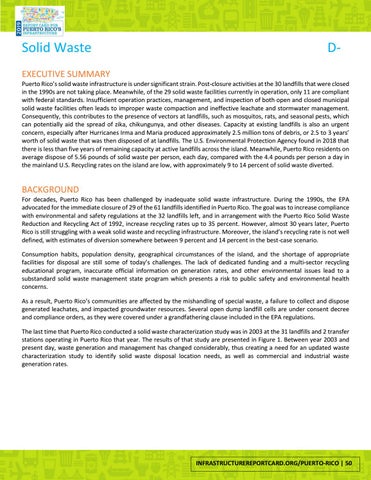Solid Waste
D-
EXECUTIVE SUMMARY Puerto Rico’s solid waste infrastructure is under significant strain. Post-closure activities at the 30 landfills that were closed in the 1990s are not taking place. Meanwhile, of the 29 solid waste facilities currently in operation, only 11 are compliant with federal standards. Insufficient operation practices, management, and inspection of both open and closed municipal solid waste facilities often leads to improper waste compaction and ineffective leachate and stormwater management. Consequently, this contributes to the presence of vectors at landfills, such as mosquitos, rats, and seasonal pests, which can potentially aid the spread of zika, chikungunya, and other diseases. Capacity at existing landfills is also an urgent concern, especially after Hurricanes Irma and Maria produced approximately 2.5 million tons of debris, or 2.5 to 3 years’ worth of solid waste that was then disposed of at landfills. The U.S. Environmental Protection Agency found in 2018 that there is less than five years of remaining capacity at active landfills across the island. Meanwhile, Puerto Rico residents on average dispose of 5.56 pounds of solid waste per person, each day, compared with the 4.4 pounds per person a day in the mainland U.S. Recycling rates on the island are low, with approximately 9 to 14 percent of solid waste diverted.
BACKGROUND For decades, Puerto Rico has been challenged by inadequate solid waste infrastructure. During the 1990s, the EPA advocated for the immediate closure of 29 of the 61 landfills identified in Puerto Rico. The goal was to increase compliance with environmental and safety regulations at the 32 landfills left, and in arrangement with the Puerto Rico Solid Waste Reduction and Recycling Act of 1992, increase recycling rates up to 35 percent. However, almost 30 years later, Puerto Rico is still struggling with a weak solid waste and recycling infrastructure. Moreover, the island’s recycling rate is not well defined, with estimates of diversion somewhere between 9 percent and 14 percent in the best-case scenario. Consumption habits, population density, geographical circumstances of the island, and the shortage of appropriate facilities for disposal are still some of today’s challenges. The lack of dedicated funding and a multi-sector recycling educational program, inaccurate official information on generation rates, and other environmental issues lead to a substandard solid waste management state program which presents a risk to public safety and environmental health concerns. As a result, Puerto Rico’s communities are affected by the mishandling of special waste, a failure to collect and dispose generated leachates, and impacted groundwater resources. Several open dump landfill cells are under consent decree and compliance orders, as they were covered under a grandfathering clause included in the EPA regulations. The last time that Puerto Rico conducted a solid waste characterization study was in 2003 at the 31 landfills and 2 transfer stations operating in Puerto Rico that year. The results of that study are presented in Figure 1. Between year 2003 and present day, waste generation and management has changed considerably, thus creating a need for an updated waste characterization study to identify solid waste disposal location needs, as well as commercial and industrial waste generation rates.
INFRASTRUCTUREREPORTCARD.ORG/PUERTO-RICO | 50
